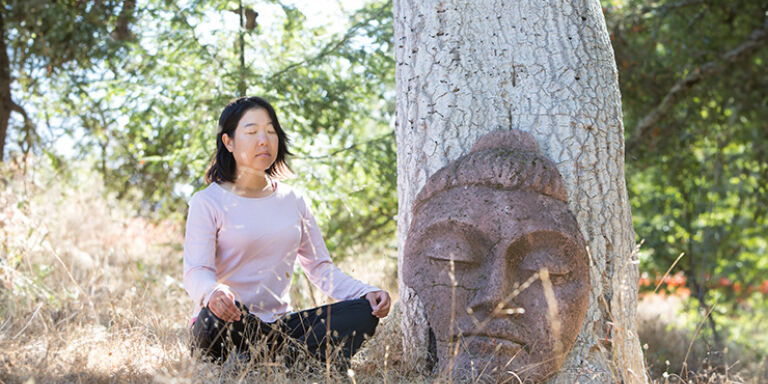As we grow in the Dharma, we feel the results both in our meditation and throughout our life. Relationships and work may become smoother as our emotions and inner stories are seen with compassion and mindfulness. In meditation we may find concentration and collectedness becoming more available. At the same time, practice is designed to reveal how we suffer, so we may find our awareness of our own difficulties and old wounds increasing, which can be painful and require patience, determination, and self-compassion.
The teachings of the Buddha are praised as being “good in the beginning, good in the middle, and good in the end” (DN 2). As we find ourselves established in our practice, new areas of inquiry open up, new details in the craft of meditation, and new understandings of basic teachings we may have heard many times. The Buddha said that he did not have a “closed fist” around the teachings, and made no distinction between secret and public teachings (SN 47.9). But he also taught for 45 years, reframing the Dharma again and again to meet the needs of those who came to study with him. One of the greatest supports for deepening in practice is to make our own relationship with the discourses, and be able to draw on the teachings directly as the needs and interests of our practice change.
In this practice guide, we begin with an overview of the Pāli Canon, the oldest record of the Buddha’s teachings available to us, and then refresh the basic frameworks of the Four Foundations of Mindfulness (satipaṭṭhāna) and the Four Divine Abidings (brahmavihāra). As in all of our Practice Guides, each section includes selected talks and writings by Spirit Rock teachers, with links to original texts for study and inspiration. And when you find yourself ready for more sustained Dharma study in community, check out the Living Dharma and Dedicated Practitioner programs, the foundational Buddhist Study & Practice programs in the Dharma Institute.

The Four Foundations of Mindfulness (satipaṭṭhāna)
The heart of Buddhist meditation is a quality of directed attention and investigation called sati, generally translated as “mindfulness.” The seventh limb of the Noble Eightfold Path, Right (or Wise) Mindfulness is a series of meditations exploring our experience of our bodies, feelings, and mental and emotional states.
Though some aspects of mindfulness have become popular, with applications from therapeutic to educational settings, the Buddha’s original instructions reveal a depth and subtlety that have the power to truly transform our lives. The aim of mindfulness, like the path as a whole, is the complete ending of suffering, called nibbāna, and the attainment of liberation.
The word satipaṭṭhāna can be translated as “foundations” or “the establishment” of mindfulness. The four foundations are:
Mindfulness of body (kāyā)
Mindfulness of feelings (vedanā)
Mindfulness of mind/heart (citta)
Mindfulness of qualities (dhamma)
Within each of these foundations is a set of instructions for investigating particular aspects of experience. After each instruction, the sutta includes a “refrain,” instructing the practitioner to observe this aspect of experience “internally, externally, and both,” to see the experience as impermanent, or to simply be aware of it “to the extent necessary for knowledge and mindfulness.” The refrain ends with the injunction to “meditate independent, not grasping at anything in the world.”
1. Mindfulness of Body (kāyā)
The section on mindfulness of body begins with a set of basic instructions on breath meditation, postures, and maintaining mindfulness throughout one’s daily activities. The subsequent meditations—on anatomy, the elements, and a corpse in decay—expand the sense of mindfulness from awareness of present moment experience into intentional reflections on the nature of the body: from the unattractiveness of bodies when thought of as separate parts, to the selflessness of bodies when understood as being composed of the same elements as everything else, to the inevitable mortality and decay of our body. These reflections bring an aspect of insight and wisdom into our practice, deconstructing the habitual ways we view and identify with our bodies.
2. Mindfulness of Feelings (vedanā)
The second foundation of mindfulness brings our attention to feelings or “feeling tone” (vedanā), the root of our more complex emotions. Vedanā points to our instinctive judgment of every experience as either pleasant (sukha) unpleasant (dukkha), or neither pleasant nor unpleasant (adukkham-asukhaṁ). Bringing mindfulness to feeling tone includes becoming aware of the initial reactions we have to our experiences, as well as to the habits and patterns that have formed over time into preferences, judgments, and aspects of personality.
3. Mindfulness of Mind/Heart (citta)
The Pāli word citta refers to both heart and mind, the inner space of experiences we call emotions, cognition, and thought. The third foundation brings our attention to states of mind/heart that are important in our development of clarity and concentration. Being mindful of these states, as well as the energetic and emotional qualities in the fourth foundation, develops the fluency with energy and emotional charge begun with mindfulness of vedanā.
4. Mindfulness of Qualities (dhamma)
The fourth foundation directs attention to five lists of qualities (dhamma) that we work with in meditation and throughout the process of inner cultivation. The lists that comprise the fourth foundation are:
The five hindrances (nīvaraṇa)
The five aggregates (khandha)
The six sense-bases (āyatana)
The seven awakening factors (bojjhaṅga)
The Four Noble Truths (ariya-saccesu)
The first and fourth lists are opposites: the hindrances are qualities that inhibit concentration and insight, while the awakening factors support concentration and insight. The second and third lists in the fourth foundation offer frameworks for cultivating insight. Both the aggregates (khandha) and sense-bases (āyatana) are frameworks for understanding experience as fluctuating phenomena arising and passing in impersonal, conditioned ways.
The final list in this foundation is the Four Noble Truths itself—the summary of the entire model of suffering, its cause, its end, and the path to the end of suffering. It is a fitting end to this overarching practice model that it closes with the signature teaching of the Buddha, with its promise of full release from suffering.
Talks & Meditations on Mindfulness of Qualities


The Four Divine Abodes (brahmavihāras)
The heart practices taught by the Buddha are embodied in a set of four sublime qualities known as brahmavihāra, or “divine abodes.” Starting with the fundamental expression of universal love known as lovingkindness (mettā), the brahmavihāras taken together describe the awakened heart: warm, balanced, and responsive to the world.
The four brahmavihāras are:
Lovingkindness (mettā)
Compassion (karuṇā)
Sympathetic Joy (muditā)
Equanimity (upekkhā)
1. Lovingkindness (mettā)
The Pāli word mettā means “friendliness” and is also translated as “lovingkindness,” “benevolence,” and simply “love.” Mettā is a form of love that wishes other beings to be well and at ease, regardless of our personal connection to them. The training in mettā begins with cultivating warmth and friendliness for ourselves and those we know personally, then expands to gradually include all beings: those we don’t know personally, those who are difficult to love, and ultimately everyone in the universe.
The practice of mettā is detailed in the beloved discourse “The Buddha’s Words on Lovingkindness” or Mettā Sutta (Snp 1.8). Mettā is the foundation of all four brahmavihāras. The other three qualities can all be understood as variations of lovingkindness that arise in different circumstances.
2. Compassion (karuṇā)
Compassion arises when lovingkindness encounters suffering. The impartial friendliness of mettā wishes for others’ well-being, and when pain and distress are perceived, it naturally becomes the wish that they be free of that pain and distress. Compassion is distinct from empathy, or “feeling with” another’s experience. Compassion does not aim to feel the pain another is experiencing, but rather aims to care for them and wish for their well-being in a way that is free from grasping or attachment. The near enemy of compassion is pity, which cares for another’s suffering but can also look down on them with blame or judgment.

Talks & Meditations on Compassion
3. Sympathetic Joy (muditā)
Sympathetic or appreciative joy is the manifestation of mettā that arises when well-being is encountered. The counterpart to karuṇā (compassion), muditā is a natural expression of mettā that celebrates another’s good fortune without jealousy or judgment. Because muditā rejoices in well-being, it is closely related to generosity, which rejoices in supporting others through giving and service. When oriented toward ourselves, muditā can take the form of gratitude, appreciating our well-being through being thankful for the good fortune that has come to us.
4. Equanimity (upekkhā)
The culminating brahmavihāra is equanimity (upekkhā), which balances the other three by bringing impartiality and balance of heart to the foreground. Equanimity is a deep wisdom quality, situated at the end of many of the Buddha’s lists, including the seven factors of awakening and the ten perfections. A form of mettā mixed with wisdom, upekkhā supports us to understand that the suffering or ease beings experience is due to the conditions of their life and their own past actions, rather than our wishes for them. Knowing this, the heart grows in the ability to stay open and kind regardless of circumstances.
Interdependence & Global Community
Just as we never master the practices of meditation and lovingkindness, but always find that there’s more to experience, more to learn, and more to awaken to, the practice of waking up to the conditions that shape our world is ongoing. The study of history, focusing on social justice and the practice of collective action that expresses compassion for the suffering of the world, can be thought of in Buddhist terms as the study of conditionality. The Buddha described conditionality as that which connects any situation or experience with what happens next.
When this exists, that is; due to the arising of this, that arises.
When this doesn’t exist, that is not; due to the cessation of this, that ceases.
(SN 12.21)
This teaching points to how everything we experience arises from actions in the past and their results in the present, and how our actions in the present become the conditions for the future. We understand conditionality to be both one of the most central teachings of the Buddha and a powerful lens through which to understand the relationship between the Dharma and social action.
The painful impacts of past actions such as those that fueled colonialism, slavery, Indigenous genocide, and environmental devastation are still resonating throughout the world. Unless both individuals and communities understand their relationship to those conditions, and work to change the social structures that perpetuate oppression, the nature of conditionality is that the harm is bound to continue.
These talks suggest some doorways for inquiry and exploration of socially-engaged practice. For reading lists and sources for further education, explore our resource pages on interdependence and engagement and Indigenous cultures and the Spirit Rock Land.





















